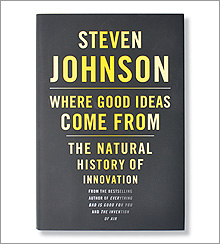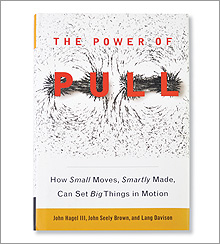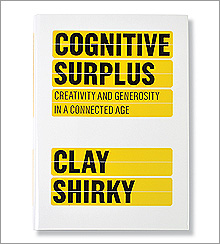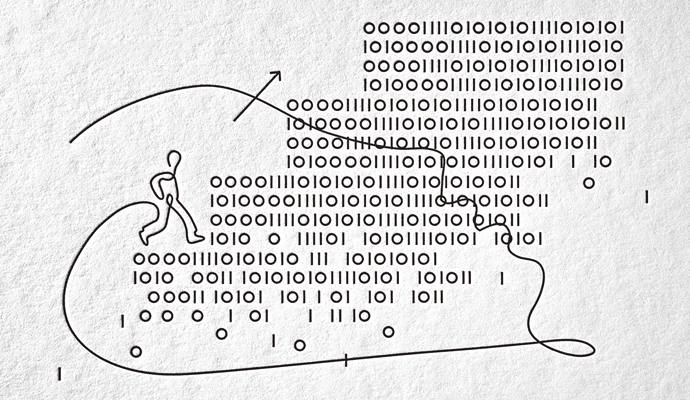Best Business Books 2010: Innovation
Innovation as a Social Act
(originally published by Booz & Company)Steven Johnson
Where Good Ideas Come From: The Natural History of Innovation (Riverhead, 2010)
John Hagel III, John Seely Brown, and Lang Davison
The Power of Pull: How Small Moves, Smartly Made, Can Set Big Things in Motion
(Basic Books, 2010)
Clay Shirky
Cognitive Surplus: Creativity and Generosity in a Connected Age
(Penguin Press, 2010)
When I was a young engineer, I thought innovation was primarily a technological act aimed at creating new gadgets and devices. Then I became an entrepreneur and learned that innovation is also a business act, requiring the application of sound management principles. Now that I’m in the academic world, working at the intersection of entrepreneurship and innovation, I realize that innovation — in its truest, most productive form — goes far beyond the marriage of business and technology. Innovation is first and foremost a social act, and it requires human connections to thrive.
A surprising number of this year’s books on innovation are focused on the application of design principles to products and companies. They are worthy books, and it’s good to see design thinking gain wider recognition. But this ground has already been broken, and they are for the most part how-to books — perhaps useful, but not particularly original. Instead, the year’s best business books on innovation explore new territory and illuminate the fundamental social principles that underlie the innovation process.
A single thread weaves through these books: Innovation is a team effort. But not a team effort in the ways that you might imagine. It’s an effort among individuals, organizations, and society as a whole. Each book highlights a different aspect of the social life of innovation, along the winding path that ideas take through creation, diffusion, and transformation.
Creation
To put the social aspect of innovation in context, let’s rewind a few millennia. According to Steven Johnson, the author of Where Good Ideas Come From: The Natural History of Innovation, sometime between 10,000 bc and 5000 bc, humankind hit a watershed moment: People began inventing in earnest. Before that, they built on one another’s ideas so slowly that it took 30,000 years to advance from mining to metallurgy. But then a big shift happened. They cast aside their hunter-gatherer ways and settled in cities, and shortly thereafter, a giant explosion of innovation occurred. The alphabet, currency, measuring sticks, aqueducts, cement, writing, bread, and wheels — these are just a handful of the vast number of world-changing inventions that our forebears developed during this period.
Something happened when humans put down roots, Johnson argues. Ideas started bouncing between individuals, growing and improving, in a web of connections he calls liquid networks. Unlike a gas, in which molecules rarely bump into one another, or a solid, in which molecules do not move from place to place, a liquid represents a free-flowing, high-contact medium. Cities provided such an environment for human thought; ideas collided within them, people learned faster, and ideas spread more widely.
I would point out that this notion of liquid networks can also help explain why universities are such hotbeds of creativity. Academia is based on the philosophy of sharing and building on ideas in an open environment, with students and faculty in close proximity, creating a rich intellectual stew. Accordingly, over the years universities have germinated game-changing ideas as diverse and valuable as the Internet, recombinant DNA technology (the basis for the biotechnology industry), liquid crystal displays, magnetic resonance imaging, Kentucky bluegrass, Plexiglas, open source software, the pacemaker, insulin, rocket fuel, and the seat belt, just to name a few.
To support his thesis, Johnson cites a global study by Geoffrey West, a theoretical physicist and former head of the Santa Fe Institute. West found that the creativity of a city scales to the quarter power with respect to size. What that means is that a metropolis 50 times the size of a nearby town is, on average, 130 times more innovative on measures such as the quantity of inventors, number of inventions, research and development budgets, and so on. Further, West found that the average resident in that city is three times as creative as his or her smaller-town neighbor.
Johnson offers double-entry bookkeeping, a key tool in the practice of capitalism, as an example of an important innovation arising from liquid networks. Described by Goethe as one of the “finest inventions of the human mind,” double-entry bookkeeping was codified in the trade capitals of northern Italy during the Renaissance. Its development, says Johnson, stemmed from the spillover of ideas from one merchant to the next as markets morphed from the feudal system into early capitalism, and relationships between people became less hierarchical and more interconnected. Interestingly, despite the importance of the innovation, no one person ever claimed credit for it.
Examples like these have implications for the design of office space and business processes. The proverbial watercooler — the site of countless discussions ranging from the gossipy to the profound — can have an incredible generative effect. John Seely Brown, former director of Xerox PARC (Palo Alto Research Center), once told me how the center’s coffeemaker was connected to its computer network, sending a friendly notice when the coffee was brewed to lure researchers into impromptu social moments that helped feed their creative culture. Organizations as diverse as the highly successful Pixar Animation Studios Inc., owned by the Walt Disney Company, and CERN (the European Organization for Nuclear Research), the organization responsible for the Large Hadron Collider near Geneva, design cafés and social areas into the core of their buildings so that employees with varying job descriptions can serendipitously meet and form their own liquid networks. Executives who are overly focused on titles and reporting structures should take note: Networks can be much more powerful than hierarchies in stimulating the creation and sharing of ideas.
In addition to liquid networks, Johnson explores six other patterns that underlie especially fertile ecosystems for innovation: the adjacent possible, the slow hunch, serendipity, error, platforms, and exaptation (a term borrowed from biology for the functional shift of a trait during an evolutionary process). Each pattern is illustrated with delightfully fresh and often surprising examples from a wide array of sources — history, evolutionary biology, chemistry, the U.S. Department of Homeland Security, urban planning, digital culture, and neurology — which stretch the reader’s mind, cultivating new ideas in and of themselves. Although the book does not address the social impacts of creativity per se, its themes and examples clearly underscore the role that social phenomena play in the shaping and creation of ideas. For these reasons, I feel it is the best business book of the year on innovation.
Diffusion
Social interaction is a critical factor in the generation of ideas, but innovation is more than creativity. Innovation is the process of transforming new ideas into tangible societal impact. Society plays an essential role in this process, which starts when a concept has sparked but before the fire has spread.
An idea is not an innovation unless it is adopted and scaled, and the innovator’s ability to harness society in this quest can either make or break the idea. Addressing this challenge, The Power of Pull: How Small Moves, Smartly Made, Can Set Big Things in Motion, by John Hagel III, John Seely Brown, and Lang Davison, starts where Johnson’s book leaves off. (Disclosure: John Seely Brown is a friend of mine and a member of the board of councilors that advises me at the University of Southern California’s Stevens Institute for Innovation.)
The Power of Pull paints an optimistic view of the world based on a new paradigm, called “pull,” which is enabled by an unprecedented acceleration in technology and can be highly profitable if harnessed effectively. Under this paradigm, individuals and corporations must develop the ability to pull together the building blocks of successful innovation, to “draw out people and resources as needed to address opportunities and challenges,” according to the authors. This new world belongs to “global hunter-gatherers” who repeatedly put themselves into serendipitous situations. They skillfully attract and connect with one another to rapidly add value to their projects, and they add reciprocal value to the initiatives of others.
The pull approach stands in sharp contrast to the old-fashioned mind-set of “push,” in which organizations try to anticipate demand and push their ideas, in the form of products and services, out to their customers. In this paradigm, bigger is better, resources are scarce and centrally allocated, elites do the deciding, and all negotiations are zero-sum games. The authors offer compelling and frightening evidence that this widely used approach is outmoded and has led to great instability and diminishing returns for today’s corporations: Competition is intensifying on a global scale, customer loyalty is declining, corporate returns on assets have dropped to less than a quarter of what they were a few decades ago, stock prices are much more volatile, and churn in the S&P 500 is accelerating. By all measures, the authors conclude, corporations are ailing, no matter how hard they push.
In the push world, knowledge is an asset to be closely guarded. But in the pull world, knowledge goes out of date much too rapidly to hoard. Modern hunter-gatherers share knowledge because they know they can create more value by harnessing the flow of new knowledge than they can by capturing and stockpiling it. The authors illustrate this point with examples from the software and apparel industries, in which companies have leveraged customers, suppliers, and stakeholders in their search for innovation.
Take, for example, the experience of SAP AG, one of the world’s largest software companies, during its transition to a service-oriented architecture. Company leaders were convinced they had a great product on their hands. The value of their technology was not the issue. Their concern was customer adoption, and they faced a chicken-and-egg scenario in which customers would not be able to see the benefits of the new product until they had worked with it. In light of this conundrum, the company launched a series of forums, blogs, wikis, and videos called the SAP Developer Network, which encouraged peer-to-peer interactions. With 1.2 million people now participating in these online communities and helping one another, the program has been very successful at both accelerating product adoption and building and sharing knowledge.
At first, The Power of Pull may sound like a reprise of Henry W. Chesbrough’s book, Open Innovation: The New Imperative for Creating and Profiting from Technology (Harvard Business School Press, 2003). But the authors of The Power of Pull are talking about much more than a short-term transactional approach to finding and exploiting ideas; they advocate developing longer-term relationships based on trust.
Relying on such trust-based relationships to accelerate one’s business lies outside the comfort zone of most corporations, but it can lead to incredible results. I saw this firsthand in 2009 when the USC Stevens Institute for Innovation worked with the prestigious TED conferences to conceive and host the first independently organized TED event, TEDxUSC. Given TED’s valuable brand and high standard for quality, I was pleasantly surprised that TED leaders agreed to explore the idea when it was still in its conceptual stage, instead of trying to maintain full control and pursue expansion opportunities solely by growing their own organization. The latter action would have followed the traditional push model. But TED’s leaders took a chance, and once we helped work out the kinks, they established the TEDx licensing program, which enables nonprofit organizations to host independently organized, TED-like events. Within a year, nearly 1,000 TEDx events were scheduled in 60 languages all around the globe.
The Power of Pull should prompt executives to reconsider how knowledge, intellectual property, and collaboration are managed within their companies and how key functions, such as HR, IT, and customer support, should be changed to take advantage of this new paradigm. It should also prompt such questions as: How can power and influence be channeled to the company’s edges and into its networks? How can pull enable the company to learn faster and better? What would the company be like if developing talent were its first priority? And most importantly, how can the business attract and access the intellectual energy of people outside its borders for maximum scale and success?
Hagel, Seely Brown, and Davison take a broad view of innovation, citing examples as wide-ranging as multinational corporations, teen surfers in Maui, Iranian protesters, World of Warcraft gamers, and entrepreneurs. The book is dense; at times it feels as though the authors tried to fit too much into their manifesto. Expect to spend some time digesting it; its ideas are complex — but also genuinely game-changing.
Transformation
Society plays a critical role in the development and successful diffusion of innovations, but it also affects innovations in a third way: It shapes them. And often, it changes them in ways that are outside the control of innovators, meaning that the best innovators can do is anticipate and adapt. A good way to do that is to read Clay Shirky’s new book, Cognitive Surplus: Creativity and Generosity in a Connected Age.
Shirky, who teaches in New York University’s Interactive Telecommunications program, has proven to be one of the most insightful writers on the revolutionary effect of the Internet. In this book, he digs deep into the social DNA of humankind to tell a story — an unfinished story — of an opportunity of global scale that he challenges the reader to meet. In the process, he illuminates how society’s partnership with innovation can lead to surprising and wonderful results.
The world has time on its hands, says Shirky, an inordinate amount of free time totaling more than a trillion hours a year, which is now spent mostly in front of the television in many modern societies. But instead of watching TV, he argues, people should be using those hours in creative endeavors, sharing their work for societal gain.
I celebrate this as an idea whose time has come — yet again. A hundred years ago most of us would have been rolling up our sleeves to make a living or to fix something that was broken. Looking further back, the creative acts of singing, dancing, and telling stories by the campfire were an essential part of our everyday lives. It’s only recently, in the last half century, that we have been turning our backs on our tribal heritage of creating and sharing. We’ve become consummate consumers, of products, services, and media. Fortunately, however, the Internet — our new digital campfire — has finally begun to patch up our temporary estrangement from our communal nature.
It is in this context that Shirky introduces a big opportunity, and it’s only natural that our social side should embrace it. The Internet and its tools have reduced the cost of and lowered the barriers to creating content and connecting people. As a result, everyone who has access to these wonders has the opportunity to shape the future. For instance, the photographs that people upload and the reviews they post by the millions can become the collective foundation for future applications and communities. With this newfound ability to participate, people can contribute to world-changing innovations, like Ushahidi.com, a crowdsourced, online reporting platform that was first used by Kenyans to report violent crimes in real time, and now has spread globally.
Shirky is a great storyteller. He weaves his points into a journey that is thought-provoking and accessible; he explores the many facets of social science for insights that are fresh and relevant. Cognitive Surplus strikingly illustrates how society is guiding the ultimate direction of many innovations. Businesspeople should take heed. If they don’t, they might miss how social media is shaping their industries, underestimate the opportunity to leverage stakeholders and customers in the creation of their products and services, and fail to grasp the influence of open source models on their bottom line.
I would offer Facebook as an excellent example of harnessing society’s ability to influence innovation. “I could have never imagined all of the ways people would use Facebook when we were getting started 6 years ago,” founder Mark Zuckerberg wrote in July 2010, the day the company’s user base hit 500 million. Zuckerberg’s willingness to allow his customers to shape his site has been a key ingredient in Facebook’s runaway success.
My one disappointment with Shirky’s book is that it focuses only on new digital tools, and misses a parallel revolution that is enabling people to create and share in the physical world. The up-and-coming “maker” culture — highlighted in Cory Doctorow’s sci-fi novel Makers (Tor, 2009) and Chris Anderson’s article “In the Next Industrial Revolution, Atoms Are the New Bits” in Wired magazine in 2010 — is powered by a new box of tools accessible to practically anyone: US$2,000 CNC (computer numerical control) machines and $1,000 MakerBot 3-D printers, easy-to-program microcontrollers like the Arduino, public open-access workshops like TechShop, and micro-factories and global supply chains ready to manufacture and ship small batches of a new product anywhere around the world. Manufacturing is becoming democratized; your next-door neighbor might be building the next electric car or manufacturing and selling accessories for the iPad.
The implications of this mashup of free time and tools, whether physical or digital, should not be understated. Shirky demonstrates how a convergence of opportunity, means, and motivation will enlarge society’s role in innovation. The only question that remains: What benefit will emerge? Shirky wonders whether we will use our new digital tools for pursuits as trivial as lolcats — or for saving lives. He is optimistic about the answer. Let’s hope he is right.
The ultimate insight to be gained from this year’s best business books is that innovation is a team effort and we are all on the team. So although innovation concerns translating ideas into societal impact, it equally concerns the impact of society on the ideas. It is this complex interplay between people and ideas that makes the process of innovation so challenging — and so fascinating.![]()
Author profile:
- Krisztina “Z” Holly is vice provost for innovation at the University of Southern California and executive director for the USC Stevens Institute for Innovation. She was the founding executive director of MIT’s Deshpande Center for Technological Innovation, and has been an engineer and entrepreneur.






